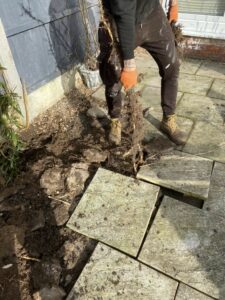Bamboo encroachment across property boundaries causes disputes between homeowners
Bamboo encroachment across property boundaries causes disputes between homeowners, who are unaware of the risks.
Homeowners are unaware of the risks posed by encroachment of bamboo from adjoining properties and the costs of repairing the serious damage it can cause, reports invasive plant specialist Environet.
A new YouGov survey of over 2,000 people commissioned by Environet, found that almost a fifth (18%) of British adults have had bamboo on their own or an adjacent property. Yet, despite the serious threat bamboo poses, spreading faster and further than Japanese knotweed, only 24% of people would be concerned if it was growing near their home, suggesting a lack of awareness of the risks. The plant’s aggressive spread via long lateral roots extending up to 30ft from the parent plant, is also likely to trigger disputes, with close to 1 in 10 (9%) of those affected having had their relationships with neighbours impacted by encroachment.
Hardy, fast-growing and tolerant of most soil types, bamboo is popular for its screening qualities, creating privacy in overlooked gardens. Commonly planted in borders and along boundary fences, it has the ability to push through brickwork, drains, patios, cavity walls and even cracks or weaknesses in concrete.
In Knutsford, Cheshire, homeowner Isobel Chetwood wasn’t initially aware that the tenants next door had planted bamboo along their adjoining boundary, but quickly came to realise there was a problem when shoots began to appear in a raised bed she had designated for strawberry plants. She began to cut down the new growth, but it was a losing battle as the plant took hold.
Isobel said:
“Last year the bamboo shoots started appearing prolifically and I could see it was clearly coming from next door.
“My raised bed is constructed of brick and heavy wooden sleepers, which you’d think is fairly robust, but in no time at all the bamboo was forcing its way beneath the sleepers, pushing them apart.”
After Isobel approached the landlord of the property next door to alert him to the problem, he treated the infestation with weedkiller. But that only focused the plant’s energy on growing more vigorously in Isobel’s garden and new shoots began to emerge at an alarming rate.
Isobel continued:
“I commissioned Environet to carry out a survey of the infestation and sent it to the landlord; I think that’s when he realised we needed professional help.
“Fortunately, his landlord’s insurance covered the cost of excavating the bamboo on my side of the fence, but he had to pay for the removal on his side since it had been deliberately planted by tenants.
“I’d advise anyone thinking about planting bamboo to avoid it at all costs.
“It shouldn’t be sold at garden centres at all in my opinion, or at least not without a clear warning.”
Using a mechanical digger, Environet excavated enough bamboo root and rhizome to fill two entire skips, which involved digging up a patio to remove the extensive network of bamboo runners embedded underneath. The work cost approximately £10,000 in total.
In 2022, at a property in Hampshire, a bamboo infestation that had spread from next door exploited a weakness in the foundations of a property to emerge through the floor in the living room, hall and kitchen, resulting in the excavation of the entire ground floor at a cost of over £100,000.
Nic Seal, founder and Managing Director of Environet, said:
“Bamboo encroachment is one of the most common problems we deal with, since unlike knotweed, it’s still being marketed and sold in garden centres up and down the country with no warning of the risks – and planted directly into the ground by unsuspecting homeowners.
“There are hundreds of varieties of bamboo and it might take ten years, but most types will become invasive eventually.
“Since it’s usually planted along boundaries, it can very quickly lead to legal disputes which are expensive to resolve.
“As such cases become more common, I wouldn’t be surprised if mortgage lenders start to look more closely at the issue and impose lending restrictions, similar to those for Japanese knotweed.
“That would at least provide some protection to innocent homebuyers who unwittingly inherit a problem that could subject them to costly removal work and even a legal claim.”
What to do if bamboo encroaches into your property:
-
- Firstly, do not ignore the problem. A few stray runners are normally an indication of a much bigger problem to come. Early action will prevent costs from escalating.
- Speak to your neighbour and attempt to resolve the issue amicably. They may not have realised the bamboo has spread or understand the risks posed to both properties.
- Commission a professional to survey the property, to determine the source of the bamboo infestation, the extent of the problem and devise a plan to resolve it. It’s usually best for a bamboo infestation that has spread to multiple properties to be treated as one, but this relies on the cooperation of all the affected neighbours.
- If the neighbour refuses to cooperate, you will need to notify them in writing and ask them to take action to prevent the ‘nuisance’.
- If they still fail to tackle the problem satisfactorily, you may choose to seek legal advice and pursue a claim to recover removal costs, the cost of repairing any damage and your legal costs.
- If a neighbour has bamboo in the garden which is threatening to encroach but has not yet crossed the boundary, alert them to the risks and ask them to remove it or install a root barrier to prevent its spread into your property.
Kindly shared by Environet UK



















